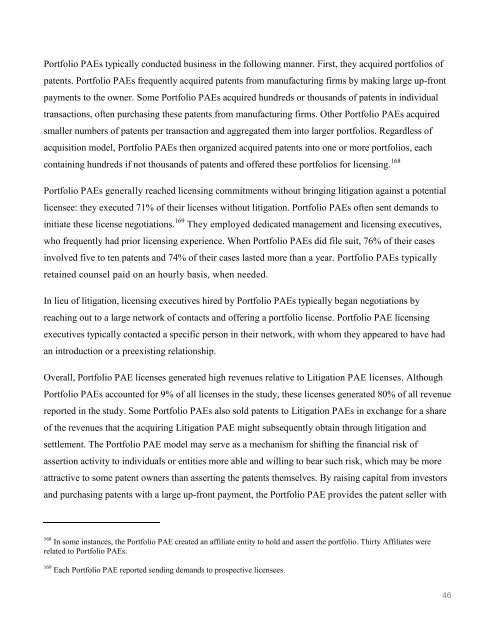You also want an ePaper? Increase the reach of your titles
YUMPU automatically turns print PDFs into web optimized ePapers that Google loves.
Portfolio PAEs typically conducted business in the following manner. First, they acquired portfolios of<br />
patents. Portfolio PAEs frequently acquired patents from manufacturing firms by making large up-front<br />
payments to the owner. Some Portfolio PAEs acquired hundreds or thousands of patents in individual<br />
transactions, often purchasing these patents from manufacturing firms. Other Portfolio PAEs acquired<br />
smaller numbers of patents per transaction and aggregated them into larger portfolios. Regardless of<br />
acquisition model, Portfolio PAEs then organized acquired patents into one or more portfolios, each<br />
containing hundreds if not thousands of patents and offered these portfolios for licensing. 168<br />
Portfolio PAEs generally reached licensing commitments without bringing litigation against a potential<br />
licensee: they executed 71% of their licenses without litigation. Portfolio PAEs often sent demands to<br />
initiate these license negotiations. 169 They employed dedicated management and licensing executives,<br />
who frequently had prior licensing experience. When Portfolio PAEs did file suit, 76% of their cases<br />
involved five to ten patents and 74% of their cases lasted more than a year. Portfolio PAEs typically<br />
retained counsel paid on an hourly basis, when needed.<br />
In lieu of litigation, licensing executives hired by Portfolio PAEs typically began negotiations by<br />
reaching out to a large network of contacts and offering a portfolio license. Portfolio PAE licensing<br />
executives typically contacted a specific person in their network, with whom they appeared to have had<br />
an introduction or a preexisting relationship.<br />
Overall, Portfolio PAE licenses generated high revenues relative to Litigation PAE licenses. Although<br />
Portfolio PAEs accounted for 9% of all licenses in the study, these licenses generated 80% of all revenue<br />
reported in the study. Some Portfolio PAEs also sold patents to Litigation PAEs in exchange for a share<br />
of the revenues that the acquiring Litigation PAE might subsequently obtain through litigation and<br />
settlement. The Portfolio PAE model may serve as a mechanism for shifting the financial risk of<br />
assertion activity to individuals or entities more able and willing to bear such risk, which may be more<br />
attractive to some patent owners than asserting the patents themselves. By raising capital from investors<br />
and purchasing patents with a large up-front payment, the Portfolio PAE provides the patent seller with<br />
168<br />
In some instances, the Portfolio PAE created an affiliate entity to hold and assert the portfolio. Thirty Affiliates were<br />
related to Portfolio PAEs.<br />
169<br />
Each Portfolio PAE reported sending demands to prospective licensees.<br />
46


